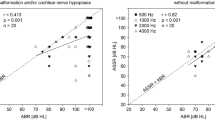Abstract
To assess the reliability of Blackman windowed tone burst auditory brainstem response (ABR) as a predictor of hearing threshold at low frequencies. Fifty-six subjects were divided in to three groups (normal hearing, conductive hearing loss, sensorineural hearing loss) after pure tone audiometry (PTA) testing. Then they underwent tone burst ABR using Blackman windowed stimuli at 0.5 kHz and 1 kHz. Results were compared with PTA threshold. Mean threshold differences between PTA and ABR ranged between 11 dB at 0.5 kHz and 14 dB at 1 kHz. ABR threshold was worse than PTA in each but 2 cases. Mean discrepancy between the two thresholds was about 20 dB in normal hearing, reducing in presence of hearing loss, without any differences in conductive and sensorineural cases. Tone burst ABR is a good predictor of hearing threshold at low frequencies, in case of suspected hearing loss. Further studies are recommended to evaluate an ipsilateral masking such as notched noise to ensure greater frequency specificity.


Similar content being viewed by others
References
Lins OG, Picton TW, Boucher BL, Darieux-Smith A, Champagne SC (1996) Frequency-specific audiometry using steady state responses. Ear Hear 17:81–96
Stapells DR (2002) The tone-evoked ABR: Why it’s the measure of choice for young infants. Hearing J 55:14–18
Stapells DR, Picton TW, Perez-Abalo MC, Read D, Smith A (1985) Frequency specificity in evoked potential audiometry. In: Jacobson JT (ed) The Auditory Brainstem Response. College Hill Press, San Diego, CA, pp 147–177
Picton TW (1978) The strategy of evoked potentials audiometry. In: Gerber SE, Mencher GT (eds) Early diagnosis of hearing loss. Grune and Strutton, New York, pp 279–308
John MS, Brown DK, Muir PJ, Picton TW (2004) Recording Auditory Steady-State Responses in Young Infants. Ear Hear 25:539–553
Dimitrijevic A, John M, Picton W (2004) Auditory Steady-State Responses and Word Recognition Scores in Normal-Hearing and Hearing-Impaired Adults. Ear Hear 25:68–84
Perez-Abalo MC, Savio G, Torres A, Martin V, Rodriguez E, Galan L (2001) Steady State Responses to Multiple Amplitude Modulated Tones: an Optimized Method to Test Frequency-Specific Threshold in Hearing-Impaired Children and Normal Hearing Subjects. Ear Hear 22:200–211
Canale A, Lacilla M, Cavalot A, Albera R (2006) Auditory steady state responses and clinical applications. Eur Arch Otorhinolaryngol 263:499–503
Picton TW, Durieux-Smith A, Champagne SC, Whittingham J, Moran LM (1998) Objective evaluation of aided threshold using auditory steady state responses. J Am Acad Audiol 9:315–331
Davis AE, Barnard S, Beagley HA (1985) Acoustic brainstem responses for clinical use: a comparison of pure tone stimuli with wide band clicks. Clin Otolaryngol Allied Sci 10(5):243–247
Purdy SC, Abbas PJ (2002) ABR thresholds to tonebursts gated with Blackman and linear windows in adults with high-frequency sensorineural hearing loss. Ear Hear 23(4):358–368
Johnson TA, Brown CJ (2005) Threshold prediction using the auditory steady-state response and the tone burst auditory brain stem response: a within-subject comparison. Ear Hear 26(6):559–576
Hood LJ (1998) Clinical applications of the ABR in neurological testing. In: Hood LJ (ed) Clinical Applications of the Auditory Brainstem Response. Singular Publishing Group, Inc., San Diego-London, pp 67–91
Albera R, Canale G, Magnano M, Lacilla M, Morra B, Rugiu MG, Cortesina G (1991) Relationship between pure-tone-audiometry and slow vertex responses. Acta Otorhinol Ital 11:551–562
Albera R, Roberto C, Magnano M, Lacilla M, Morra B, Cortesina G (1991) Evaluations on slow vertex response waveform identification. Acta Otorhinol Ital 11:543–549
Stapells DR, Gravel JS, Martin BA (1995) Thresholds for auditory brain stem responses to tones in notched noise from infants and young children with normal hearing or sensorineural hearing loss. Ear Hear 16(4):361–371
Stapells DR, Picton TW, Durieux-Smith A, Edwards CG, Moran LM (1990) Thresholds for short-latency auditory-evoked potentials to tones in notched noise in normal-hearing and hearing-impaired subjects. Audiology 29(5):262–274
Delaroche M, Thiébaut R, Dauman R (2006) Behavioural audiometry: validity of audiometric measurements obtained using the “Delaroche Protocol” in babies aged 4–18 months suffering from bilateral sensorineural hearing loss. Int J Pediatric Otorhinolaryngol 70:993–1002
Stapells DR, Picton TW (1981) Technical aspects of brainstem evoked potential audiometry using tones. Ear Hear 2(1):20–29
Conflict of interest
The authors declare that they have no conflict of interest.
Author information
Authors and Affiliations
Corresponding author
Rights and permissions
About this article
Cite this article
Canale, A., Dagna, F., Lacilla, M. et al. Relationship between pure tone audiometry and tone burst auditory brainstem response at low frequencies gated with Blackman window. Eur Arch Otorhinolaryngol 269, 781–785 (2012). https://doi.org/10.1007/s00405-011-1723-7
Received:
Accepted:
Published:
Issue Date:
DOI: https://doi.org/10.1007/s00405-011-1723-7



